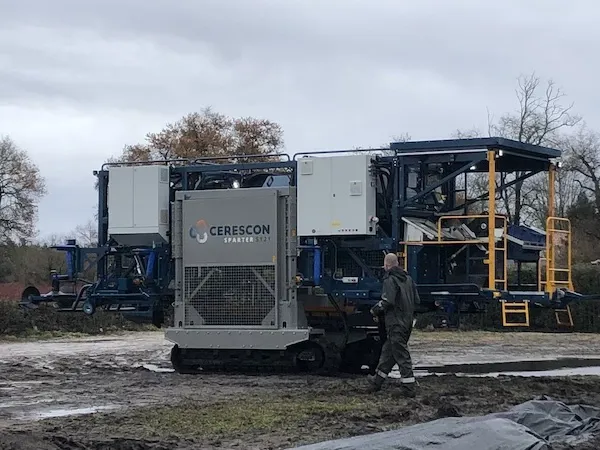Last Friday, the professionals of the asparagus sector gathered at Planasa to watch a demonstration of the Sparter, the first robot that can harvest asparagus developed by the Dutch company Cerescon. In a context where labor, which represents 40% of the production costs, is getting increasingly difficult to find, this robot is like an inevitable step in the development of the sector.
Ad Vermeer (co-founder of Cerescon), Thérèse Van Vinken (co-founder of Cerescon), Frédéric Faillières (director of Planasa) and Christian Befve (founder and manager of the consulting company Befve & Co)
The Cerescon team, Frédéric Faillières and Christian Befve
A great technological stride…
This technical innovation is characterized today by a machine that is able to harvest 2,200 asparagus per hour (3,200 theoretically without including the half-turns made by the machine), thanks to a system of sensors detecting the asparagus up to 10cm below the surface. A true revolution in the sector that will allow up to three days between the harvests, compared to 48h between the current manual harvests. Another significant advantage: the machine can work 24h a day, at the speed of 1.1s per asparagus, which corresponds to a surface area of 0.3 ha/h. The machine provides the equivalent work of 15 to 20 pickers.

In order to obtain asparagus of optimal quality, the sensors remove themselves before coming into contact with the vegetable, which is then retrieved vertically, together with the soil that surrounds it. Brought to the conveyor belt by the picking arm, the asparagus ends up in a storage crate of 250kg, and the soil is returned to its original place. Thanks to two different detectors placed 6cm apart on the same vertical axis, the asparagus are cut in a homogeneous manner to obtain a length of about 22cm. As for the quality obtained, the Dutch and German producers who have tested the machine claim that the asparagus harvested industrially are less purple, less flowery and less curved than the ones harvested manually.
Still in need of improvement …
This harvesting robot marks a real turning point in the history of the asparagus, but it will still take some time for the machine to be profitable and for industrialized harvesting to be optimal. To this day, 12 types of damage to the asparagus have been observed and are being analyzed to be corrected. If the sensors are able to detect the asparagus up to 10cm below the surface, they still cannot differentiate very well two asparagus growing close to each other. Especially since there is no possibility to choose from which caliber the robot can harvest the asparagus.
Not all asparagus can be harvested by a robot today. The producers using hoops for their asparagus production cannot use the machine for their harvest. And for the machine to operate optimally, there must be enough space between the rows. A particularity of the French production, introduced a few years ago by leading asparagus specialist Christian Befve in order to facilitate the harvest.
But this machine of 10,500 kg also has a cost of 375,000 euros [424,134 USD], not including the annual maintenance costs of nearly 10,000 euros [11,310 USD]. The Dutch company is currently looking for French partners to provide technical assistance in case the machine breaks down.
At the moment, 6 machines are operational. Three were bought by Dutch producers, one is being tested in the Netherlands, and two others are going from producer to producer in Germany and they are now also available for the French market.
An inevitable yet puzzling evolution
The robot has sparked a lot of interest, but it still leaves some producers perplexed, fearing a “devaluation of the asparagus”, a renowned vegetable whose prestige lies in the hard labor involved in its manual harvest. “The asparagus philosophy” could be lost if its harvest becomes robotized.
According to Christian Befve, this robot represents “a step” for the sector. “It was obvious that we would get there. It is a step. Just as it was when the first machines appeared to harvest the vineyards or the bean fields. It does not mean that the asparagus will lose value. The robotization will lead to a segmentation of the market. The asparagus harvested by a machine on the one hand, and the asparagus harvested by hand on the other. The robotization could lead to a democratization of the asparagus and a gain in market shares in the future.”
For more information:
cerescon.com










